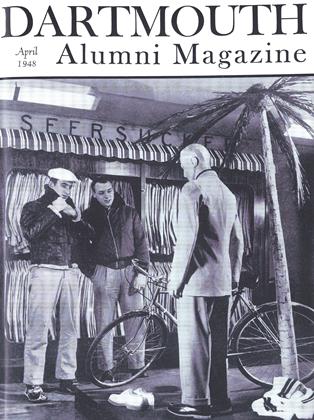Repository of 119,000 Teaching Items
WILSON HALL, formerly the College library and now the home of the Dartmouth College Museum, is something of a museum piece itself. Once inside its Victorian portals, however, the visitor is pleasantly surprised by the modern, interesting atmosphere; and if he is there to learn, he has at his disposal three large floors of instructive, well-planned exhibits ranging over the major fields of biology, anthropology and geology. A museum of this scope and professional quality is rare among undergraduate colleges, and that it is appreciated by the college community and beyond Hanover is evidenced by the steady growth of its activities, its collections and its attendance records. All this adds up to a tribute to the Museum's director, Prof. W. Wedgwood Bowen, who during the past 14 years has developed an educational adjunct that is a distinct credit to Dartmouth.
The Dartmouth College Museum is primarily a teaching museum. In addition to its more striking permanent exhibits in Wilson Hall, it has extensive study collections in its Bissell Hall annex, where most class work is done. Courses in ornithology and entomology are taught entirely in the Museum, and classes from all three curriculum divisions make occasional visits to study special collections. The Museum also operates a sort of campus extension service and last year loaned teaching specimens to the departments of art, botany, French, geography, geology, sociology and zoology. Schools of the Hanover region are also making increasing use of the Dartmouth Museum, accounting in part for the steady climb in number of visitors. Last year the Museum chalked up an attendance record of more than 14,000 persons.
The Museum's collections have grown at an even greater rate and now number more than 119,000 specimens. Space permits the exhibition of only a fraction of these, but everything in the Museum's possession is methodically catalogued and stored and is immediately accessible for study use. The need for altering and enlarging Wilson Hall—a program halted by the war—becomes more urgent every year.
In addition to directing the entire Museum, Professor Bowen serves as Curator of Biology. Elmer Harp Jr. is Curator of Anthropology and Robert G. Chaffee '36 will soon assume the vacant post of Curator of Geology. The College Naturalist, Douglas E. Wade, now operates within the orbit of the Museum, and the College's new and unique Arctic program also has its base there, with David C. Nutt '41 on the staff as Arctic Specialist and the noted explorer, Vilhjalmur Stefansson, as Consultant.
THE MUSEUM'S HOME: Wilson Hall, built in 1885 as a library, was turned over to the Museum in 1929, after construction of Baker. It pro- vides 11,577 square feet of floor space for public exhibits.
IN THE ANTHROPOLOGY SECTION: Above Prof. Robert A. McKennan '25 takes his sociology class to the Museum to examine the Victor M. Cutter 'O3 Collection of Central American archaeology. Below, in the ethnology room, a typical display case contains models and specimens
A MAIN-FLOOR DISPLAY of birds of the world is typical of the attractive way the Museum exhibits its collections. Grown out of a small New England nucleus, this is now a very representative collection.
BUTTERFLIES AND BEETLES, in this mainfloor cor- ner, provide more than a colorful backdrop for the student's picture. He is working hard to classify them for Professor Bowen's entomology course.
IT'S A SMALL DISPLAY BUT THOSE WHO WORK HARD TO PREPARE IT: A popular and lively feature of the Museum's program is the exhibit in the Hanover Inn Lobby, starte this year. Left, Director Bowen spruces up a Quetzal bird, sacred bird of the Aztecs. Center, Elmer Harp, curator of anthropology, handles the major task of assembing and describing items on Mexico South. Right, the finished display is ready for alumni, students and other visitors to the Inn.
ONE OF THE BIGGEST ATTRACTIONS in the Mu- seum is the oriental collection given by Robert L. Ripley '39h of "Believe-lt-Or-Not" fame. This shows only one corner of the room devoted to rare items collected by Mr. Ripley in his travels around the world to assemble material for his writings.
A FASCINATING PLACE FOR CHILDREN, the Mu- seum is being used more and more by schools from the entire surrounding region. Above, a group of Hanover second-graders are engrossed in the in- spection of a life-like habitat group of red foxes.
BEHIND THE SCENES a tremendous amount of work goes into field trips, research, receiving and preparing specimens, and cataloguing every item the Museum owns. Left, John Gustafson '4B puts together the pieces of an Indian cooking pot unearthed on a Museum expedition. Right, Director Bowen, in the Bissell Hall annex, checks over a study collection, part of the thousands of items never seen in the display cases but important to the Museum as a teaching institution.
 View Full Issue
View Full Issue
More From This Issue
-
 Article
ArticleStumps and Scholarships
April 1948 By ROBERT S. MONAHAN '29 -
 Class Notes
Class Notes1942
April 1948 By JAMES L. FARLEY, JOHN H. HARRIMAN, ADDISON L. WINSHIP II -
 Class Notes
Class Notes1897
April 1948 By WILLIAM H. HAM, WELD A. ROLLINS, MORTON C. TUTTLE -
 Class Notes
Class Notes1918
April 1948 By ERNEST H. EARLEY, DONALD L. BARR, DAVID L. GARRATT -
 Class Notes
Class Notes1931
April 1948 By A. W. LAUGHTON, WILLIAM H. SCHULDENFREI, ERNEST H. MOORE -
 Class Notes
Class Notes1919
April 1948 By J. K. HUNTINGTON, MAX A. NORTON, ROSCOE .A. HAYES








